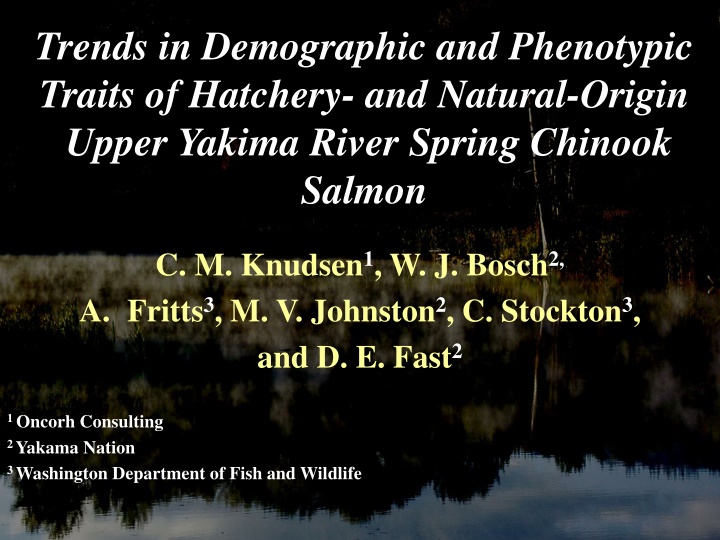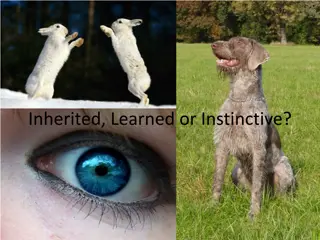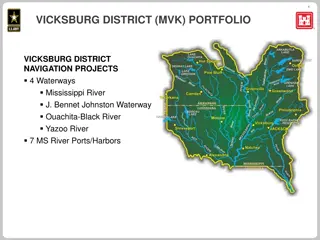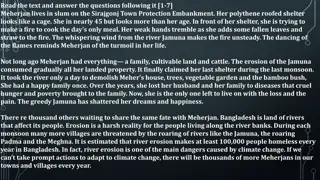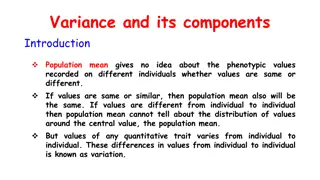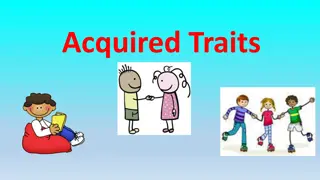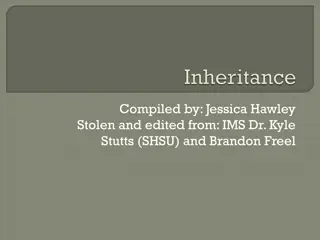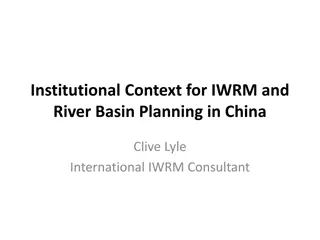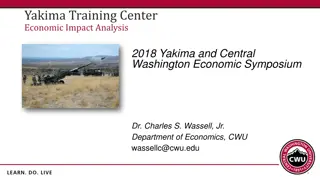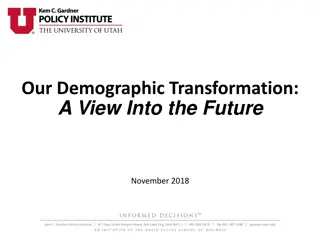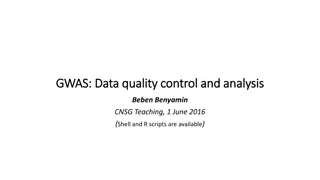Trends in Demographic and Phenotypic Traits of Upper Yakima River Spring Chinook Salmon
This study compares demographic and phenotypic traits of hatchery and natural-origin Spring Chinook Salmon populations in the Upper Yakima River. It analyzes differences in length and trends over time for age 4 fish, as well as minijack rate comparisons and feed ratio studies. The population definitions of Natural Origin, Standard Hatchery, and Hatchery Control are examined, along with comparisons between Standard Hatchery and Hatchery Control populations. The research delves into the genetic differences arising from hatchery influences across multiple generations, providing insights into the evolution of these salmon populations.
Download Presentation

Please find below an Image/Link to download the presentation.
The content on the website is provided AS IS for your information and personal use only. It may not be sold, licensed, or shared on other websites without obtaining consent from the author.If you encounter any issues during the download, it is possible that the publisher has removed the file from their server.
You are allowed to download the files provided on this website for personal or commercial use, subject to the condition that they are used lawfully. All files are the property of their respective owners.
The content on the website is provided AS IS for your information and personal use only. It may not be sold, licensed, or shared on other websites without obtaining consent from the author.
E N D
Presentation Transcript
Trends in Demographic and Phenotypic Traits of Hatchery- and Natural-Origin Upper Yakima River Spring Chinook Salmon C. M. Knudsen1, W. J. Bosch2, A. Fritts3, M. V. Johnston2, C. Stockton3, and D. E. Fast2 1 Oncorh Consulting 2 Yakama Nation 3 Washington Department of Fish and Wildlife
Objectives 1. Compare NO, SH and HC populations over brood years 2002 to 2010 for age 4 s. Compare differences in Length (POHP) and estimate trends over time. 2. HC vs SH Minijack rate comparisons. Trends over time. Revisit the Feed Ration Study (BY2002-2004)
Population Definitions Natural Origin (NO) progeny of naturally spawning parents. Parents could be natural or hatchery origin. Hatchery Origin Standard Hatchery (SH) Origin Parental broodstock of NO only, one generation of domestication. Used to supplement the naturally spawning population, an integrated hatchery program. Hatchery Control (HC) Origin Parental broodstock of hatchery origin only. Multiple generations of domestication. Are not allowed to naturally spawn, a segregated hatchery line.
HC vs SH Comparisons Both have parents artificially spawned, share hatchery rearing and post-release environments (fresh and saltwater) SH returns have experienced a single generation of hatchery influence (NO parents) HC returns have experienced multiple generations of hatchery influence (HC parents) Differences in their phenotypic traits should be expressions of genetic differences due to the additional generations of hatchery influence experienced by the HC line
HC population begins in BY2002 founded from first generation hatchery returns (SH) 3rd generation of HC return (4 gen. of hatchery influence) 2nd generation of HC fish return (3 generations of hatchery influence) Broodyears 2002 2003 2004 2005 2006 2007 2008 2009 2010 2011 2012 2005 3 2006 4 3 2007 5 4 3 2008 5 4 3 2009 5 4 2010 5 2011 2012 2013 2014 2015 Time 3 4 5 3 4 5 3 4 5 3 4 5 3 4 5 3 4 3
Objective 1 Compare differences in Length (POHP) and trends over time.
Age 4 POHP Length 63 2 Generations Difference 1 Generation Difference 3rd Gen POHP length (cm) 61 59 HC SH NO 57 2006 2007 2008 2009 Return year 2010 2011 2012 2013 2014
Pairwise Regressions of POHP SH vs NO Adj R2 = 0.879, df = 9 p < 0.001 HC vs NO Adj R2 = 0.746 df = 9 p = 0.002 HC vs SH Adj R2 = 0.852, df = 9 p < 0.001
Age 4 POHP Length In 17 of 18 pairwise comparison NO age 4 fish are larger than either SH or HC fish. 63 NO SH HC POHP length (cm) 61 59 57 2006 2007 2008 2009 Return year 2010 2011 2012 2013 2014
Age 4 POHP Length 63 NO SH HC POHP length (cm) 61 59 57 2006 2007 2008 2009 Return year 2010 2011 2012 2013 2014
2 SH and HC lines are Diverging by 0.11 cm/year (SH-HC) POHP (cm) 1 0 Adj R2 = 0.463 df = 7, p-value = 0.03 -1 2002 2004 2006 2008 2010 Brood Year
Differences From NO Population Mean NO-HC difference = 1.2 cm Mean NO-SH difference = 0.8 cm Equal means p-value = 0.09 Both slopes not significantly different from 0 3 (NO-Population) POHP (cm) 2 1 Difference 0 NO-HC NO-SH -1 2002 2004 2006 2008 2010 Brood Year
Objective 2: HC vs SH Minijack rates 1.Trends over BY2002 to BY2010 2.Revisit the Feed Ration Study (BY2002- 2004)
Slopes and means not sign. different Adj. R2= 0.378, p = 0.002, slope = 3%/year 0.6 HC 0.5 SH 0.4 Proportion MiniJacks 0.3 SH 0.2 0.1 HC 0.0 -0.1 -0.2 2000 2002 2004 2006 2008 2010 2012 Brood Year
Paired Differences: SH and HC MiniJack Proportions 0.6 HC SH SH-HC Difference 0.5 0.4 HC and SH are converging Adj. R2= 0.398, df = 8, p = 0.041 Proportion MiniJacks 0.3 0.2 0.1 0.0 -0.1 -0.2 2000 2002 2004 2006 2008 2010 2012 Brood Year
HC vs SH Minijack rates 1.Revisit the Feed Ration Study (BY2002- 2004)
Feed Ration Study Design 50% of hatchery production was reared on a High Ration diet and 50% on a Low Ration diet. Replicated over 3 brood years (2002-2004). There were two populations treated: HC and SH. Genetic effects on Treatments were controlled.
Controlling for Genetic (Family) Effects There are 9 pairs of raceways at CESRF: 8 SH pairs and 1 HC pair. Each RW in a pair was randomly assigned a Treatment: High or Low Ration. Eggs from approximately 24 females were divided in half and allocated to each raceway. Treatments within pairs (High and Low Ration) were represented by the same families. Differences in traits are strictly environmental, not genetic.
Body Size-Time Growth Trajectory With Reaction Norms for Maturation These fish mature and leave the cohort Year 2 Maturation Will mature in Year 3 Body size Maturation Threshold Year 1 Maturation Maturation Threshold Year 2 Year 1 Time
Body Wt Over Time Feed Study NOAA Acclim. Sampling LO 02 HI 02 LO 03 HI 03 LO 04 HI 04 20 Maturation Threshold Period High ration 15 Mean Body wt (g) Low ration 10 On avg. High 33% heavier 5 0 Apr May Jun Jul Aug Sep Oct Nov Dec Jan Feb Mar
Logistic Regression: ln(Body wt) vs Prob. Maturation HC High HC Low SH High SH Low
Parameter Estimates Z p-value Constant BY Treatment Origin ln(Body wt) BY * ln(Body wt) Origin * ln(Body wt) 0.002 0.002 0.050 0.019 0.004 0.004 0.005 10,333.027 -5.167 -0.538 3.086 -3.091 -1.956 2.344 -2.910 2.914 -2.782 HC High HC Low 6.313 -3,626.768 1.814 -2.795 SH High SH Low ln(Body wt) ln(Body wt) ln(Body wt)
Summary Objective 1 All 3 populations are highly correlated in size over time (R2>0.75, p<0.01), due to very similar freshwater and ocean rearing environments. Age 4 NO fish are larger in 94% (17 of 18) of the pairwise comparisons. SH fish are larger that HC (8 of 9 years). SH and HC populations are diverging in length at the rate of 0.1 cm/year.
Summary Objective 2 Minijack temporal trends of SH and HC were equal (no significant difference in slopes or means). Both SH and HC minijack rates were significantly increasing over time (3% per yr). HC and SH minijack rates show are converging, becoming more similar.
Summary Objective 2 contd The HC population s norm of reaction for maturation from the logistic regression showed significant variation over the 3 years of the feed study In comparison, the SH population was very stable. More work needed here.
Acknowledgements Charlie Strom, DJ Brownlee, Greg Strom, Simon Goudy, and Quinn Jones (CESRF) helped process and sample fish. Mark Johnston and his crew collected and sampled fish at Roza. WDFW personnel Jamie Schlump, Brian Johnson, Danielle Rockey, Rebecca Powell, and Matt Sizer helped sample during the spawning season. BPA provided funding.
Does the proportion of jacks used as broodstock affect subsequent jack production? Taken from: Cassinelli, et al. 2012. 2011 CALENDAR YEAR HATCHERY CHINOOK SALMON REPORT: IPC AND LSRCP MONITORING AND EVALUATION PROGRAMS IN THE STATE OF IDAHO. IDFG Report Number 12-02.
Return Years 2001 to 2012 Natural and Hatchery Origin Passage date increasing at 1.8 days/year Regression p-values<0.052 7/8 Hat Adults NO Adults Median RAMF passage date 6/18 5/29 5/9 2000 2002 2004 2006 2008 2010 2012 2014 Return year
2001 to 2014 Return Years Hatchery Origin 1.2 days per year, p=0.078 7/8 Hat Adults NO Adults Median RAMF passage date Natural Origin 0.8 days per year, p=0.216 6/18 5/29 5/9 2000 2002 2004 2006 2008 2010 2012 2014 Return year
20 T-test Mean difference=0 Mean difference = 3.8 days t = 3.47, df = 13, p-value = 0.004 Difference (Hatch-NO) Passage Date Roza 15 10 Temporal Trend Regression Adj. R2 = 0.050, p-value = 0.22 5 0 -5 2000 2010 2015 2005 Return Year
Instantaneous Growth Rate (IGR) HC SH NO 0.000 -0.001 Instan. Growth Rate -0.002 Females -0.003 -0.004 -0.005 Males -0.006 -0.007 2008 2009 2010 2011 Return year
Age 4 Roza Body Mass 5.0 NO SH HC 4.5 Body weight (kg) 4.0 3.5 3.0 2014 2006 2007 2008 2009 2010 2011 2012 2013 Return year
